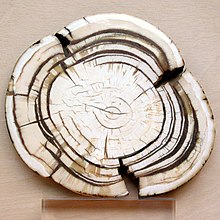Mammal tooth
Teeth are common to most
Most extant mammals including humans are diphyodonts, i.e. they have an early set of deciduous teeth and a later set of permanent or "adult" teeth. Notable exceptions are elephants, kangaroos, and manatees, all of which are polyphyodonts, i.e. having teeth that are continuously being replaced.
Mammal teeth include incisors, canines, premolars, and molars, not all of which are present in all mammals. Various evolutionary modifications have occurred, such as the lack of canines in Glires, the development of tusks from either incisors (elephants) or canines (pigs and walruses), the adaptation of molars into flesh-shearing carnassials in Carnivora, and others.
Diversity
The extant mammalian infraclasses each have a set
Rabbits
Anatomy of rabbit teeth
The incisors and cheek teeth of rabbits are called aradicular hypsodont teeth. Aradicular teeth never form a true root with an apex, and hypsodont teeth have a high crown to root ratio (providing more room for wear and tear).[4] This is sometimes referred to as an elodont dentition, meaning ever-growing. These teeth grow or erupt continuously. The growth or eruption is held in balance by dental abrasion from chewing a diet high in fiber.
Rodents
Like those of rabbits,
Humans
Afrotherians
Elephants

Elephants' tusks are specialized incisors for digging food up and fighting. Elephants are polyphyodonts whose teeth are similar to those of manatees, and it is notable that elephants are believed to have undergone an aquatic phase in their evolution.
Elephants have four molars, one on each side of the upper and lower jaw. Until age 40, these are replaced by larger molars. The new molars shift forward from the back of the jaw as the old wear down. The final set of molars last for about twenty years.[9]
Manatees
Manatees are polyphyodonts with mandibular molars developing separately from the jaw and are encased in a bony shell separated by soft tissue.
Aardvarks
In
Ungulates
Horses
An adult
Horse teeth can be used to estimate the animal's age. Between birth and five years, age can be closely estimated by observing the eruption pattern on milk teeth and then permanent teeth. By age five, all permanent teeth have usually erupted. The horse is then said to have a "full" mouth. After the age of five, age can only be conjectured by study of the wear patterns on the incisors, shape, the angle at which the incisors meet, and other factors. The wear of teeth may also be affected by diet, natural abnormalities, and cribbing. Two horses of the same age may have different wear patterns.
A horse's incisors, premolars, and molars, once fully developed, continue to erupt as the grinding surface is worn down through chewing. A young adult horse will have teeth which are 4.5-5 inches long, with the majority of the crown remaining below the gumline in the dental socket. The rest of the tooth will slowly emerge from the jaw, erupting about 1/8" each year, as the horse ages. When the animal reaches old age, the crowns of the teeth are very short and the teeth are often lost altogether. Very old horses, if lacking molars, may need to have their fodder ground up and soaked in water to create a soft mush for them to eat in order to obtain adequate nutrition.
Pigs
Tusks, which grow larger in males and in wild boars, are derived from the canine teeth, a trait shared with warthogs.
Cetaceans
The toothed whales, comprising the
Carnivorans
In the order Carnivora, many different diets are not always meat. Carnivores possess diverse carnassial teeth. The carnassials are specialized teeth for different diets of different animals.[12] These teeth are used to cut through flesh.[12] Either the molars or both the premolars and molars in combination may be adapted into shearing carnassials. Tooth roots can be great indicators of diets[13][14]. In a study done on the bear tooth root area,[14] it was found that the amount of space a tooth root took up was an indicator of the bite force required from the species. For example, Panda teeth had the deepest root systems because of their bamboo diet.[14] Ursidae (bears) is not the only carnivorous family whose root area has been studied. It has been found that in general, carnivore tooth roots are highly dependent on their diets.[12]
Walrus
Walrus tusks are canine teeth that grow continuously throughout life.[15]
Dogs
In dogs, the teeth are less likely than humans to form dental cavities because of the very high pH of dog saliva, which prevents enamel from demineralizing.[16]
References
- ^ Dental Anatomy & Care for Rabbits and Rodents
- ^ Brown, Susan. Rabbit Dental Diseases Archived 2007-10-14 at the Wayback Machine, hosted on the San Diego Chapter of the House Rabbit Society. Page accessed April 9, 2007.
- ^ Ryšavy, Robin. The Missouri House Rabbit Society, hosted by the Kansas City Missouri House Rabbit Society. Page accessed April 9, 2007.
- ISBN 978-0-7020-4943-9, retrieved 2020-03-05
- ^ Caceci, Thomas. Veterinary Histology with subtitle "Digestive System: Oral Cavity" found here Archived 2006-04-30 at the Wayback Machine.
- ^ Malocclusion in the laboratory mouse
- epithelial stem cellniche in the tooth of two rodent species. Development (2003). 130(6):1049-57.
- ^ AM Hunt. A description of the molar teeth and investing tissues of normal guinea pigs. J Dent Res. (1959) 38(2):216-31.
- ISBN 0-8343-0051-6
- ^ ISBN 0-683-30403-8
- ^ Al Cirelli, Equine Dentition (PDF), Nevada: University of Nevada, retrieved 7 June 2010
- ^ S2CID 73568494.
- .
- ^ S2CID 91721909.
- ^ The Permanent Canine Teeth, hosted on the University of Illinois at Chicago website. Page accessed February 5, 2007.
- ^ Chris C. Pinney, The Illustrated Veterinary Guide for Dogs, Cats, Birds, and Exotic Pets (Blue Ridge Summit, PA: TAB Books, 1992), p. 187.
External links
- Beach, Chandler B., ed. (1914). . . Chicago: F. E. Compton and Co.
